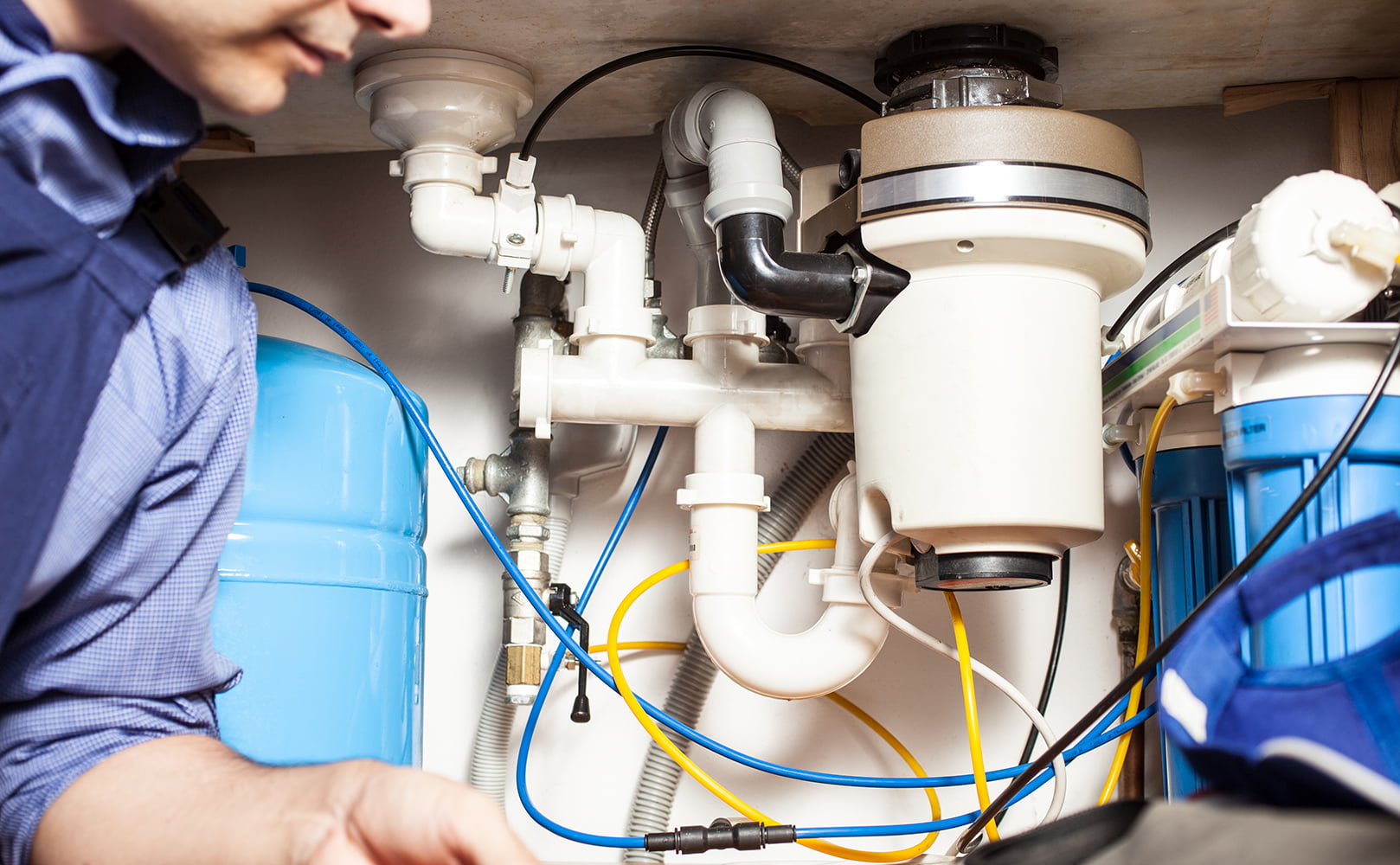Is Reverse Osmosis Water Good for You or Is It Bad to Drink?
Written by: Gene Fitzgerald // Last Updated: Jul 21, 2023
This page may contain affiliate links. If you buy a product or service through such a link we earn a commission at no extra cost to you. Learn more.
If you have been researching reverse osmosis water treatment for your home, then you’ve undoubtedly come across some information that questions its safety.
Understandably, this may be off-putting, but it is essential to take a minute to separate fact from fiction and understand where these claims come from and if there is any legitimate evidence behind them.
Today we will be looking at all the common rumours and myths that are floating around about RO water and discuss if there is actually any validity to them.
Key Takeaways
- Reverse osmosis water is much safer to drink than highly contaminated feed water.
- If you are concerned about the lack of minerals in your reverse osmosis water, we recommend you remineralize it manually or by adding a remineralization post-filter to your RO system.
Is Reverse Osmosis Water Good for You? Is It Safe to Drink?
So, is reverse osmosis good for you, as in safe to drink? Or is reverse osmosis water bad for you?
Generally speaking, reverse osmosis water is safe to drink. If your water supply has harmful contaminants, and a reverse osmosis system is removing those contaminants, your water is much safer to drink and better for you than if those contaminants remained in the water. So compared to a potentially harmful alternative of water containing pathogens and heavy metals etc., reverse osmosis water is definitely good for you.
Many of the claims suggesting RO water is not good for you are based on the fact that healthy minerals are removed in the filtration process, which is true. However, it is likely safer to drink water that is contaminant-free, even if that means it is also free of calcium and magnesium etc.
The only thing worth pointing out here is that drinking too much reverse osmosis water can cause your body to start eliminating minerals faster than normal. This might call for remineralization if you don’t get minerals from any other sources. In fact, this is what we recommend.
Would it be better if only the unhealthy contaminants were removed from the water, leaving the good? Ideally, yes, but it isn’t possible – at least not with reverse osmosis. Luckily, you can simply use remineralization to get those nutrients back into your water before consumption.
Myths – Why Reverse Osmosis Water Could Be Bad for You
There are several common myths we hear from people considering investing in a reverse osmosis system, focused on its potential ‘harmfulness’. So, let’s do some myth-busting.
Myth 1: RO Water Is Unhealthy Because It Lacks Minerals
While it is true that reverse osmosis water removes the majority of minerals from water, it doesn’t mean that the water is unhealthy per se. Your intake of essential minerals comes mostly from food, with minerals from drinking water only providing a small percentage.
That isn’t to say that the minerals in non-filtered water aren’t important, they are especially in cases where the intake of them from foods is not sufficient.
A couple of meta studies have hypothesized and shown some correlation between the consumption of low-mineral water and adverse health effects, but they have also noted that the older studies they relied on do not comply with modern research standards.
In 2003, the WHO gathered a group of medical, scientific, and nutrition experts to examine the possible long-term health consequences of drinking demineralized water. They concluded that only a few minerals found in drinking water might be of importance for the overall dietary intake, namely calcium and magnesium (both of which can be added back into the water after filtration).
Myth 2: RO Water Attacks Your Body Because It’s Low TDS
Another common claim is that RO water attacks the body and harms its mucous membranes due to its low amount of total dissolved solids (TDS). However, there is significant evidence of humans consuming low TDS water for extended periods of time by now, with no known adverse health consequences reported.
In Vancouver, BC, their municipal drinking water is naturally low in TDS, and most of the population has been consuming it for years without issue.
So it’s important to make a distinction here: Reverse osmosis water doesn’t attack your body, but it can cause your body to start eliminate minerals faster than normal. Again, remineralization is recommended.
Myth 3: The WHO Has Issued a Warning Against RO Water
A quick google search shows so many websites stating that the WHO has issued a warning against the consumption of reverse osmosis drinking water, yet strangely enough, there is no such announcement on any WHO run webpage, and most of the warning websites are selling some other kind of water treatment system. Funny that.
The WHO has indeed commented on reverse osmosis water – however, their statements have been mostly positive, recommending the use of reverse osmosis as a water purification method. The organization did add a recommendation to remineralize reverse osmosis water before consumption, though. Specifically, they suggest adding at least 20-50 mg/l (ppm) of calcium, and 10-30 mg/l (ppm) of magnesium.
What Is Reverse Osmosis Water Purification and How Does It Work?
Reverse osmosis water purification is considered the gold standard when it comes to broad contaminant removal from water supplies.
Reverse osmosis is the process of water moving through a semi-permeable membrane with tiny pores of only .0001 microns in size. These pores are so small that only the tiny water molecules can pass through, and the larger contaminants are left on the other side.
In addition, a reverse osmosis system will usually have a few different other filtration stages, such as a carbon pre-filter stage, which eliminates chlorine that may damage the RO membrane, or a sediment filter to get rid of coarse dirt. RO systems also usually have post-filtration. Most common is activated carbon to remove residual tastes but remineralization or UV purification is also possible.
There are a few kinds of RO systems, point of use, which come in countertop or under-the-sink models, and whole house reverse osmosis systems for use if you are dealing with highly contaminated feed water.
What Does Reverse Osmosis Remove?
Reverse osmosis removes a multitude of contaminants from the water, particularly non-organic contaminants that municipal water supplies often don’t filter.
- Heavy metals such as lead, cadmium, and mercury
- VOCs (volatile organic compounds)
- Water disinfectants such as chlorine and chloramine
- Disinfection byproducts
- Pesticides and herbicides
- Minerals and salts (sodium, calcium, magnesium, potassium, fluoride)
- Sediment and silt
- Nitrates/Nitrite
- Overall Total Dissolved Solids (TDS)
- Transition metals (iron, chromium, nickel)
Remineralization: How to Add Minerals Back into RO Water
There are several methods for remineralizing reverse osmosis water after it has been filtered. The easiest solution is to install a remineralization post-filter step that will add minerals like calcium, magnesium, and potassium back into the water before it comes out of the faucet. This will also rebalance the water’s pH, and the water will taste less ‘flat’.
You can also do so manually by adding mineral drops or even mineral-rich sea salt.
Pros and Cons of Reverse Osmosis
Pro: Broad Contaminant Removal
Listing every single contaminant that reverse osmosis filtration systems remove would take us all day. But trust us, it’s highly effective at removing a broad range of pollutants.
Pro: Reverse Osmosis Water Is Free of Tastes and Smells
Reverse osmosis filtration provides water that is often cleaner than bottled water (yes, it filters out microplastics!). Because of this, it removes any odor that may be in your municipal water, and any strange tastes too.
Pro: Purified Water Available on Demand
Unlike some other water purification methods, reverse osmosis is available on demand. The under sink units have a storage tank, meaning filtered water is always available for you on demand unless you have a heavy day of use or a storage tank that isn’t big enough for your household water demand.
Most tankless units use high pressure to pump water through the system at a rapid speed, ensuring it is available whenever you turn your tap on.
Pro: Save Money and the Environment
RO filtration will save you money in the long run if you are usually a bottled water drinker. Not to mention the positive environmental implications that come with reducing your use of plastics.
Pro: Easy to Install and Maintain
Point-of-use systems are generally easy to install and basically maintain yourself, even with no prior knowledge of plumbing. Some systems are also customizable, meaning you can link them up to your ice maker or coffee machine or add extra filtration steps, such as remineralization or UV water purification.
Con: RO Water Tends to Taste a Bit Flat
Some say reverse osmosis water tastes a little bit flat. This can easily be rectified with a remineralization filter before the water moves through your RO faucet.
Con: Essential Minerals Are Removed
As discussed, reverse osmosis systems cannot differentiate between what is considered a ‘good’ impurity, such as magnesium, and the bad stuff. This leaves your water without some minerals that may benefit your health.
Con: Wastewater
Some systems will be less wasteful than others, but all of them will create wastewater, anywhere from .2 gallon up to 4 gallons of wastewater for every 1 gallon purified.
You can install a booster pump if your system produces a lot of wastewater, and this should improve the ratio.
Con: Ongoing System Maintenance
Reverse osmosis water filtration systems do require periodic maintenance. It is vital to perform your maintenance on time so as not to risk the integrity of your water.
Con: RO Water Purification Is a Slow Process
The RO process can take time. Generally, this is not an issue as most models come with a storage tank, but it is an issue if you use all the water in your tank before it can refill.
Con: Kitchen Space
A typical under-the-sink system needs considerable space, and the same goes for a countertop model. This may be an issue if you have a small apartment or kitchen.
Con: You Will Likely Need a Separate Faucet
You do not connect your RO system to your pre-installed sink faucet but instead to its own specialized and dedicated faucet. This may require drilling an extra hole in your sink or using the pre-drilled hole for your sink soap dispenser or spray hose.
Con: Direct Drain Connection
RO systems need to be hooked up to the drain pipe under your sink to dispose of all the wastewater, which requires the installation of a drain saddle.
If you have any questions about RO water for drinking please don’t hesitate to leave a comment below!
Information provided on BOS is for educational purposes only. The products and services we review may not be right for your individual circumstances.
We adhere to strict editorial guidelines. Rest assured, the opinions expressed have not been provided, reviewed, or otherwise endorsed by our partners – they are unbiased, independent, and the author’s alone. Our licensed experts fact-check all content for accuracy. It is accurate as of the date posted and to the best of our knowledge.



